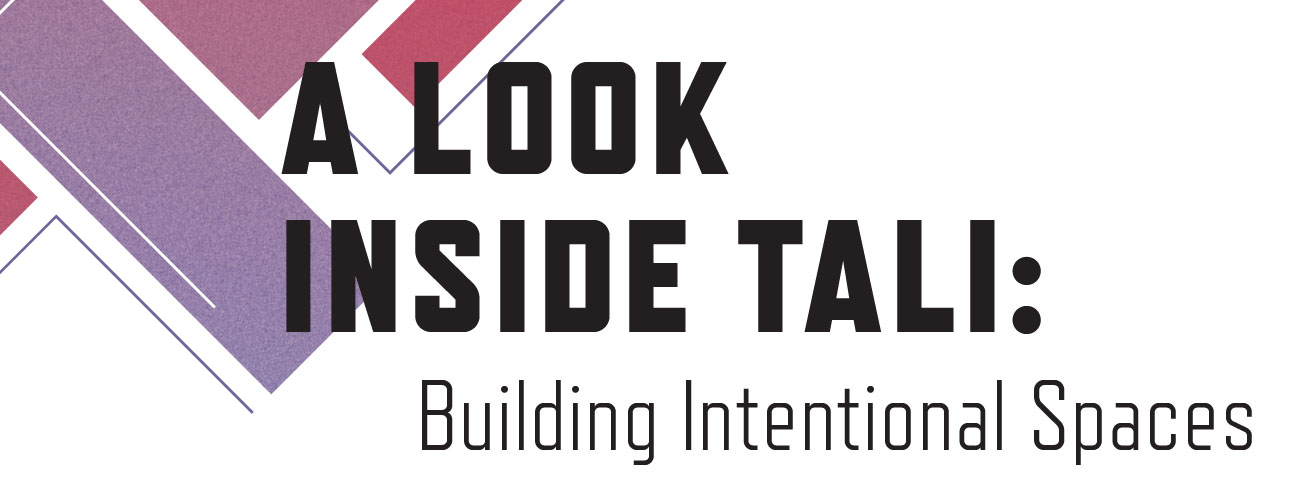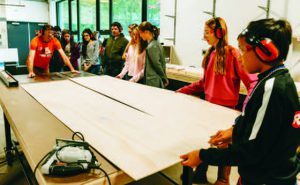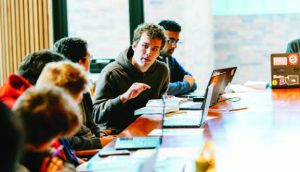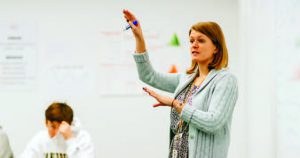
A Look Inside TALI: Building Intentional Spaces
By Verity Sayles, English Faculty
A LOT OF A LIFE HAPPENS IN TALI. IT’S MADE from 45,000,000 pounds of concrete, 15,900 square feet of metal siding, 9,000 square feet of window glazing, 5.2 tons of metal decking, twenty-two classrooms, and a 500-person theatre. In TALI, a classroom can look like a meeting of diplomats, a biology lab, a quiet stage, a practice room with a piano, a natural-light-flooded studio, or a dark media room. As we settle into the new building, here is a look at TALI from the ground up, populated with some of the folks who bring so much life to the new building we’ve started to call home.
Each day TALI comes alive to the sound of music. Music teachers Ginger Ellingson and Dr. Ed Castro arrive early to greet their Zero-Period students in the TALI building, where, Ellingson says, “The music program has a home.” The music room provides “a dedicated space designed for what we do—it’s intentional.” If you’re pulling into the Eastside Prep parking lot at 7:00 am, you’ll see Ellingson’s Chamber Choir students clustered around the piano already rehearsing. “Being on the first floor means that our work is more visible; the school community can see the hours we put in before, during, and after school,” Ellingson says. A dedicated space for rehearsal also means students can perform in the same place they practice. Learning good performance habits can now be incorporated purposefully into the music program.

Mr. MacKenzie works with students in the scene shop.
Wander from the music room to the TALI Theatre and you’ll find the heart of the building, where the community can gather and celebrate music, art, and being together. Viola player, Mallika (’21) performed recently at a school-wide assembly for MLK Day and reflected on the new space: “The sound in the area carries out to the whole audience—it elevates the performance. As a performer you are giving more to the audience and they’re receiving more from your performance.” A new feature of the Theatre is the ability to live-stream concerts to the green room. Now students awaiting their performance time can watch their peers on stage. Ellingson adds, “They get to see the whole scope of the program” by live streaming—another way community is intentionally shaped by this building.
Constructing the TALI Theatre was a massive undertaking. Over last summer you could find Rick Mackenzie up on the tension grid, hanging and addressing all the lighting instruments—around 100 different lights in total. Of the new space he says, “The Theatre is full of the latest technology that’s exciting to teach.” Students enrolled in his Stagecraft course can “now work directly onstage during class time” rather than building a set, loading it into a van, and transporting it up the road. The Upper School students in Stagecraft are trained to use the chop saw, table saw, jigsaw, welder, and a variety of hand tools to build the sets for the plays. Mackenzie says, “There is something about live performances which is so different from watching on a screen—that being in the same room while an artist is creating” and now the whole school community can share that in this new space.

Upper School students lead a discussion in the Harkness Room.
Heading upstairs to the second floor, you can find another intentional space: the Harkness Room. Harkness, or Socratic seminar, is a pedagogical practice which encourages students to work together to drive a conversation or discussion. The oval wooden Harkness table itself is a symbol of the equality of the voices at the table; the teacher has a seat in line with the students, to encourage their discourse and participate as a learner themself. The soft lights and the wood-paneled room adds a sense of import to these discussions. Caitlin McLane, Upper School social science teacher says, “I’ve had students request the Harkness Room for discussions because it feels very different than other rooms.” Reflecting on a fall term Medieval History discussion, McLane offered that the Harkness Room “truly is an equalizer because even when you have a square or a U-shaped set-up the teacher is still seen as the holder of all knowledge.” English faculty member Dr. Jonathan Larner-Lewis says, “My students seem to really up their game and take their discussions more seriously when they are seated at the Harkness table. I also think they benefit indirectly from the presence of the real books in that room.” The Harkness Room “sets a scholarly tone to the discussion and students face each other in meaningful ways.” Much akin to the way scholars of old hunkered down amongst the soft glow of candlelight and the stacks of books to pen their words and consider great ideas, so, too, do EPS students harken back to these days of old in the Harkness Room.
The intentional spaces of the TALI building allow for ideas to come to physical fruition in the laboratories, the art studios, and even in the parking garage. Of the new biology labs, teacher Adam Waltzer explains, “The new lab is designed to split in half when necessary—so we can have a traditional final exam happening on one side of the wall and an activity on the other. The tables are also designed so people can walk around and view what’s on display.” In true interdisciplinary collaboration, history teacher Ryan Aponte used the biology lab for a Prehistory final where students brought in homemade artifacts and displayed them on the tables.

Ms. Sayles teaching class in the TALI building.
From the third floor to the lower level, students are engaged in all types of making. Stop by a class on the first floor of the TALI building and you’ll find groups of students printmaking, painting, drawing, sketching, filming, cutting, and curating—all awash in the brilliant natural light of floor-to-ceiling windows. Amis Balcomb, Visual Arts faculty, says, “It’s great to finally have a home. We can settle in.” The Fine and Performing Arts faculty have spent the first part of the year getting used to the space. Balcomb loves the new storage options, where art supplies can be stored on deep shelves behind sliding white board doors; the easy access of power cords overhead; and the media room. TALI has improved the way film is taught at EPS. In the darkened media room, four crystal-clear monitors increase the visual experience for the students, while the speakers and sound system amplify the quality of their films. The Green Screen Room has expanded what students can do in the film classes, in media, and in the Broadcast Club. The green screen allows you to delete the background so students can be the stars of any scene they imagine. “The students love this space because it looks good and it looks like an art studio,” says Balcomb. “There’s respect for the space because this is a space used in a specific way. It’s not a normal room, it’s very specialized.” Balcomb continues, “Now I can choreograph my art lessons.”
Creativity can be found below decks, too. On Level One of the parking garage is a 2000 Mazda Miata. In 2016, a group of students began the huge task of converting this gas-powered Miata to an electric car. During Upper School Clubs time and after school, student-led teams are working on a variety of projects including: designing how the motor will fit to the transmission, fabricating aluminum plates to mount the batteries in the engine well, configuring the computer that will run the motor, putting the interior back together, and getting the sound system dialed in.
IT Project Manager Derek Clarke, who mentors the students, says of the new space in TALI, “It is huge. It is dry and all of our tools are right there. Rather than running back and forth from the parking lot to the tech lab, it is about five steps to every tool we need. It is well lit and has plenty of power. We also have a lift that will allow us to run wires, change breaks, and update the suspension.”
The diversity of spaces in TALI Hall allow for teachers to create homes for student interests—whether it’s singing in the choir, performing on stage, speaking their mind, filming a short, painting a scene, pipetting a specimen, or fixing the suspension on a car. Flexible, open, and engaging, the TALI building has started to feel like home.

